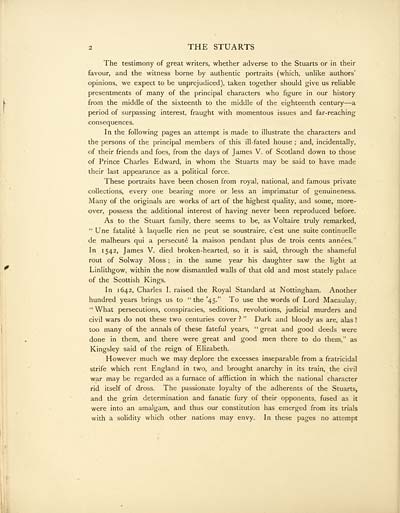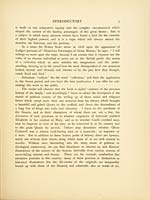Stuarts
(20) Page 2
Download files
Complete book:
Individual page:
Thumbnail gallery: Grid view | List view

2 THE STUARTS
The testimony of great writers, whether adverse to the Stuarts or in their
favour, and the witness borne by authentic portraits (which, unlike authors'
opinions, we expect to be unprejudiced), taken together should give us reliable
presentments of many of the principal characters who figure in our history
from the middle of the sixteenth to the middle of the eighteenth century — a
period of surpassing interest, fraught with momentous issues and far-reaching
consequences.
In the following pages an attempt is made to illustrate the characters and
the persons of the principal members of this ill-fated house ; and, incidentally,
of their friends and foes, from the days of James V. of Scotland down to those
of Prince Charles Edward, in whom the Stuarts may be said to have made
their last appearance as a political force.
These portraits have been chosen from royal, national, and famous private
collections, every one bearing more or less an imprimatur of genuineness.
Many of the originals are works of art of the highest quality, and some, more-
over, possess the additional interest of having never been reproduced before.
As to the Stuart family, there seems to be, as Voltaire truly remarked,
" Une fatalitd a laquelle rien ne peut se soustraire, c'est une suite continuelle
de malheurs qui a persecute la maison pendant plus de trois cents annees."
In 1542, James V. died broken-hearted, so it is said, through the shameful
rout of Solway Moss ; in the same year his daughter saw the light at
Linlithgow, within the now dismantled walls of that old and most stately palace
of the Scottish Kings.
In 1642, Charles I. raised the Royal Standard at Nottingham. Another
hundred years brings us to " the '45." To use the words of Lord Macaulay,
" What persecutions, conspiracies, seditions, revolutions, judicial murders and
civil wars do not these two centuries cover ? " Dark and bloody as are, alas !
too many of the annals of these fateful years, "great and good deeds were
done in them, and there were great and good men there to do them," as
Kingsley said of the reign of Elizabeth.
However much we may deplore the excesses inseparable from a fratricidal
strife which rent England in two, and brought anarchy in its train, the civil
war may be regarded as a furnace of affliction in which the national character
rid itself of dross. The passionate loyalty of the adherents of the Stuarts,
and the grim determination and fanatic fury of their opponents, fused as it
were into an amalgam, and thus our constitution has emerged from its trials
with a solidity which other nations may envy. In these pages no attempt
The testimony of great writers, whether adverse to the Stuarts or in their
favour, and the witness borne by authentic portraits (which, unlike authors'
opinions, we expect to be unprejudiced), taken together should give us reliable
presentments of many of the principal characters who figure in our history
from the middle of the sixteenth to the middle of the eighteenth century — a
period of surpassing interest, fraught with momentous issues and far-reaching
consequences.
In the following pages an attempt is made to illustrate the characters and
the persons of the principal members of this ill-fated house ; and, incidentally,
of their friends and foes, from the days of James V. of Scotland down to those
of Prince Charles Edward, in whom the Stuarts may be said to have made
their last appearance as a political force.
These portraits have been chosen from royal, national, and famous private
collections, every one bearing more or less an imprimatur of genuineness.
Many of the originals are works of art of the highest quality, and some, more-
over, possess the additional interest of having never been reproduced before.
As to the Stuart family, there seems to be, as Voltaire truly remarked,
" Une fatalitd a laquelle rien ne peut se soustraire, c'est une suite continuelle
de malheurs qui a persecute la maison pendant plus de trois cents annees."
In 1542, James V. died broken-hearted, so it is said, through the shameful
rout of Solway Moss ; in the same year his daughter saw the light at
Linlithgow, within the now dismantled walls of that old and most stately palace
of the Scottish Kings.
In 1642, Charles I. raised the Royal Standard at Nottingham. Another
hundred years brings us to " the '45." To use the words of Lord Macaulay,
" What persecutions, conspiracies, seditions, revolutions, judicial murders and
civil wars do not these two centuries cover ? " Dark and bloody as are, alas !
too many of the annals of these fateful years, "great and good deeds were
done in them, and there were great and good men there to do them," as
Kingsley said of the reign of Elizabeth.
However much we may deplore the excesses inseparable from a fratricidal
strife which rent England in two, and brought anarchy in its train, the civil
war may be regarded as a furnace of affliction in which the national character
rid itself of dross. The passionate loyalty of the adherents of the Stuarts,
and the grim determination and fanatic fury of their opponents, fused as it
were into an amalgam, and thus our constitution has emerged from its trials
with a solidity which other nations may envy. In these pages no attempt
Set display mode to:
![]() Universal Viewer |
Universal Viewer | ![]() Mirador |
Large image | Transcription
Mirador |
Large image | Transcription
Images and transcriptions on this page, including medium image downloads, may be used under the Creative Commons Attribution 4.0 International Licence unless otherwise stated. ![]()
| Histories of Scottish families > Stuarts > (20) Page 2 |
|---|
| Permanent URL | https://digital.nls.uk/95239291 |
|---|
| Description | A selection of almost 400 printed items relating to the history of Scottish families, mostly dating from the 19th and early 20th centuries. Includes memoirs, genealogies and clan histories, with a few produced by emigrant families. The earliest family history goes back to AD 916. |
|---|
![[Page 1]Introductory](https://deriv.nls.uk/dcn4/9523/95239281.4.jpg)
